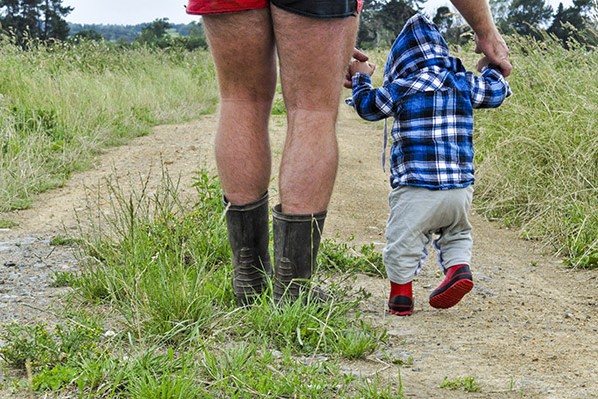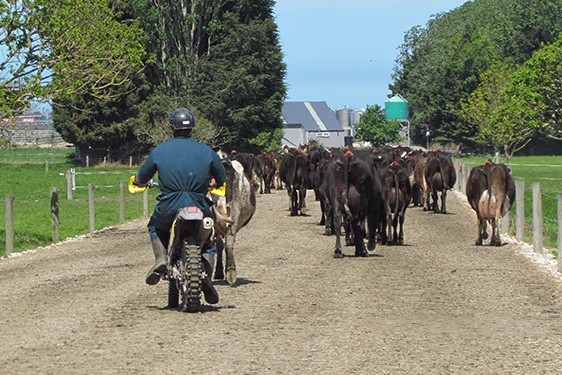Jackie Harrigan
Fifteen months into the new Health and Safety in the Workplace Act (HSWA) rural business owners risk becoming complacent around documentation and opening themselves up to possible unexpected consequences if they have an incident on their farm.
Bronwyn Muir from OnFarmSafety NZ says as a health and safety practitioner it’s an interesting phase in the rural industry – after the first flurry of rural business owners rushing to sort out the H&S systems for their business under threat of prosecution by regulator around the new law, there now is a sense of complacency creeping in, partly due to the new law being 15 months old, a large number of initial health and safety salesmen pulling out of the rural market and the regulator, WorkSafe, shifting focus from enforcement and compliance to educating.
“As a health and safety practitioner the challenge right now is that there are regulatory officials giving advice publically as to how much, or not, a documented system rural business owners need to have in place, and the message is being watered down to make it more palatable to those on the receiving end.
“What is scary now, though, is that farming teams, contractors, service providers and their businesses are being left exposed to risk of enforcement notices and prosecution.”
Muir is disappointed that mixed messaging about documentation requirements means some farmers are not capturing the level of detail and evidence they would be required to produce in the event of a notifiable incident or injury and warns farmers to strive for a comprehensive system of documenting procedures and safety protocols.
“The messaging is really confusing. Clients are on one hand being told ‘don’t worry about too much paperwork’ but on the other hand we are getting reports from our clients directly that regulatory enforcement notices are being handed out for areas of their business that apparently need an unsubstantiated level of documented evidence.
“Many farmers are verbally and practically doing good work in regard to managing risks but are not ensuring systems and documentation are in place so if they have an accident and end up in an investigation then they are not going to be able to prove and show evidence that they have taken all reasonably practicable steps – and this is a high risk place to be for a business owner.
‘Unfortunately, we know that sometimes no matter how many precautions you have in place, accidents happen, but if you don’t have evidence of decisions made and it becomes a he-said/she-said war of words, your business would probably be negatively exposed and possibly found accountable for which you will have to pay one way or another.’
“As farmers ourselves we understand how complicated it is in rural businesses to capture all the conversations we have when so much business is done over the farm gate or on the phone – verbal and practical decision-making are the order of the day 90% of the time, but somehow those verbal instructions and practical sessions need to be captured and documented to exist as a paper trail for evidence if ever required.”
Muir urges farmers to take advice from reputable rural industry-focused health and safety practitioners.
“I don’t want this to sound like we are all about butt-covering in case you have an accident. I absolutely care and want to reduce the number of injuries that occur in our industry. But we are here to help you practically manage all levels of risk, to you, your staff, anyone coming onfarm but also to your business. Could your business cope with someone getting hurt and being taken out of your farm team for an extended period and also a fine worth thousands of dollars?

“Unfortunately, we know that sometimes no matter how many precautions you have in place, accidents happen, but if you don’t have evidence of decisions made and it becomes a he-said/she-said war of words, your business would probably be negatively exposed and possibly found accountable for which you will have to pay one way or another.
“We know that the system has to be simple or it probably won’t get kept up so farmers need to think about what are their systems? How user-friendly are they and how easy is it to capture discussions that are had in an ad hoc fashion?”
She encourages farmers to use some of the many great phone apps, online tools, templates and resources that have been developed.
A further challenge to the industry, Muir says, is many health and safety practitioners have jumped on board and sold many and varied systems, some of which are were not tailored to the industry, leaving lots of half-completed systems and messes to clean up.
Bigger industry players and corporates can employ or contract a H&S representative full or part-time to support farm teams and keep their systems current and see the value in regular reviews, but the majority of farmers with one or two employees struggle to have the time of competency resource, to see the reasons or value of independent or regular reviews, she says.
“It could be they feel they have a good handle on it,” Muir says.
“But unfortunately what we are seeing when we get inside the farm gate is a folder on the shelf and some signs on the gate but very little comprehension to go with it.
“It is so much about the understanding by all on farm as to why they are doing health and safety. We spend so much time educating people and there is still a huge need for this even all these years down the track but mostly because of the mixed messaging.”
Muir suggests 20% of farmers in the industry have still not done anything about their responsibility under the Act to plan to identify and manage risks.
“Some of them are just sitting on their hands saying ’well I’ll take my chances that nothing bad will happen as I haven’t had an accident in my farming life time’ Unfortunately they may only learn the hard way which is sad as there are many resources in our industry to help them.”
One of the reasons health and safety heat has gone off a bit is because there is very little case law from prosecutions current legislation.
“We have had nine fatal accidents classified as agricultural deaths so far since the new legislation came into effect so there are investigations happening and if they go to court then we will have some case law that could drive or enforce changes in behaviour and system implementation.”
Based on WorkSafe and ACC statistics, the incident and accident rate isn’t really reducing yet and the regulator has been given a target of 25% reduction, by the Government, by 2020. If by 2020, the agricultural fatality rate doesn’t drop from the average 19 who have been killed each year for the past six years, the industry will have to rethink the strategy, because enforcement may be ramped back up to a challenging level and this will probably force the wrong incentives for culture change, Muir says.
“The rural industry collectively really needs to take ownership – it’s no good sitting back and waiting for regulators to tell us or enforce us to what we can and can’t do.
“Somehow we need to get more cohesion across the industry around health and safety standards and expectations as this will go a long way to industry showing leadership.”
Same standards across service providers
A good start to developing greater cohesion across the rural service industry could start with the newly initiated concept of a Rural National Standards Association, OnFarmSafety NZ director Bronwyn Muir says.
Muir has developed the concept and has an increasing number of parties signed up so far including Zero Harm Farm, Federated Farmers, New Zealand Young Farmers, Massey University and a number of leading organisations and farming companies.
All businesses within each industry are charged with creating their own safety standards and then communicating them as best they can to service providers and users and trickling the standards and procedures out to their clients, farm owners, managers or contractors.
But many don’t understand it or are hesitant about enforcing the policies or rules so we are still getting the tick box approach to “have you done your health and safety” because of a lack of clarity about industry expectations or standards, Muir says.
Some industry establishment examples Muir knows of that have been implemented but not collaborated on and are not only causing angst but also could unwittingly expose a number of businesses to risk according to their duties under the law – the minimum standard for fencing an effluent pond/ body of water, constant supervision by the farmer of a bulk spreader while on farm, and not being allowed to lift/stack wool bales two high in the woolshed.”
So many associations, individual industries and service providers arel charged and challenged with developing and documenting their own standards and procedures, when they could collaborate to agree industry standards that will work for all.
“If we all agree to implement and enforce the same safety operating procedures and industry standards, it would clarify risk management duties between PCBUs (persons conducting business undertakings), raise the collective bar of industry standard expectations and force some of the rural industry operators that are a bit slower to get their systems up to speed to pay attention to health and safety risk management because otherwise they may not be able to do business.”
It would also minimise the dilution of safety messages and angst between rural industries and create opportunities to proactively continue and develop.
“Hunting, recreational users, school fundraisers and trips – we shouldn’t be this far down the track and still getting so many questions about ‘should I let someone on my farm and am I liable if they get hurt?’ ” (You can, but the same rules apply as with farm workers or contractors, regarding hazards a safety risks.)
Muir has been impressed by industries outside of rural and the way they have taken on the challenge of setting up their own standards.
“Operators now have leadership around industry standards that affect their business, a platform for review of these standards as required and know what they have to do to comply – they are just getting on with business while we in the rural industry waste time and energy waiting to get permission from the regulator to operate.
“It’s about taking ownership as a rural industry, collaborating on common standards and thrashing out the issues and setting standard operating procedures for each activity with all the respective industries and service providers agreeing and then enforcing it.”
Health and safety basics
You must:
- be able to show you are managing your work risks
- identify and manage both health risks and safety risks to people in your workplace
- monitor the health of workers and workplace conditions to prevent illness and injury
- include workers and family in planning to make the farm healthy and safe
- train and supervise people who work on farm
- make sure workers and family know how to manage risks
- keep a record of notifiable events
- have procedures for dealing with workplace emergencies
- have safe and healthy facilities for workers
- make sure machinery and systems are safe for workers to use
- provide and make sure personal protective equipment is used where appropriate.
Dairy risks
Biggest risks in the dairy industry:
- Being kicked by a cow in the dairy shed
- Slips, trips, falls
- Losing control or coming off two-wheeler bike
- Being struck by cattle
- Losing control of a tractor, quad bike or side-by-side.





